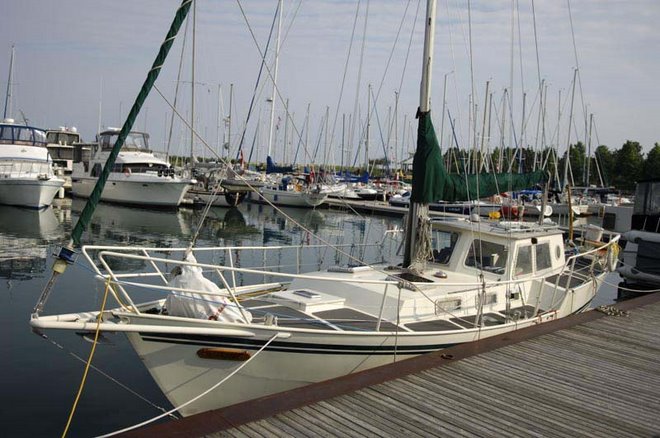 |
| Apparently it's a popular place these days. |
This is Halifax. At this point, the last day of August, we had expected to be near or nearish to it and booking interesting activities like apartments and hull treatments. But we've had a very busy last six weeks or so, and while frustrating and sweary in parts, it's also been productive. Two weeks ago, circa August 15th, we decided to overwinter here in Toronto, leave the boat in "layup afloat" (mast in, at a slip, covered over with a frame and plastic and with agitators breaking up the ice) so we can go down the St. Lawrence in spring 2020 without rushing and having honed some rather rusty sailing skills.
Also, there was this factor:
We didn't want to rush to the Maritimes chased by fall gales and not lingering in nice places because we were racing bad weather.
Nonetheless, we've now sailed some and repaired or installed a great deal more. The boat's in good, serviceable shape and we have a good game plan for doing here in Toronto what we would have done in Halifax in less familiar surroundings. We've even got a land-based apartment as I do not propose to sleep aboard the "job site".
Some refitting highlights follow. Amazing what living aboard does for one's productivity!
It's been a hot summer and we tend to skip lunch. Dinner, however, makes up for it. My belt's needed five new holes since May. Hmm.
 |
| So many parameters! |
After a rather steep learning curve with the hydraulic steering, we got the autopilot sorted and properly installed. And attractively mounted, if you ignore the previous generation of gear's mounting and conduit holes.
 |
| The rudder feedback sensor took a day to mount correctly. |
We are at the point now where the AP steers better than we can, so we let it. Basically, we input a true compass heading and correct to conditions. We derive that bearing by putting a cursor with generous offing near our desired destination and just keeping a watch on events. It's clear that a lot of local sailors are going to some waypoint very close to, say, a buoy or other nav aid. That's not so prudent when two or three of 'em do it at once, we feel.
 |
| Lazyjacks took effort: the irony did not escape me. |
Lazyjacks and two separate Dyneema-core reefing lines are now on the main. That's a safety improvement, as are the preventers we can now rig for downwind sailing in blows.
Fact is, prior to actually leaving, we haven't needed reefing lines.
Alchemy can carry a full main well past 20 knots apparent wind, and if we encounter more, we've just gone to the staysail. But all is different now.
 |
| The secondary fuel filter: Not, evidently, guilty. |
We had a big delay around August 1, when, while on a test sail in light air, our engine basically sputtered and died and only started again reluctantly and at very low RPMs. We made it back to our dock with difficulty and an odyssey of troubleshooting commenced.
 |
| And goat sacrifice to the Dark Diesel Lords. |
Basically, we were:
- 1) starved of fuel, and
- 2) the fuel was old and grotty, and
- 3) we needed to change it all, which involved moving all the batteries to access the tank tops to vacuum out crud, and
- 4) we changed all the supply side fuel lines in case of said crud, and
- 5) we installed an inline fuel pump (a Walbro FRA-1, for the intrigued), and
- 6) we changed out all the filter elements, primary and secondary.
 |
| And don't forget the goat. |
Very long, laborious story short, the problems seem solved. We've done about 50 hours of rocky and calm motoring without issue, but it took a very long process and a lot of questions strewn about to the helpful people at the club (and elsewhere, thank you!) to solve Why Won't Beta Purr? I feel we were fortunate not to bugger the injectors and we will be cycling thrugh the fuel...and the biocide for the fuel...moe quickly in the future.
 |
| Ahctual crap sailing! |
Meanwhile, there's life aboard. Frankly, it's pretty nice.
 |
| My sleep schedule's changed. |
There's a lot of sky watching...
 |
| Nothing's ripped! |
...and practising sailing in various modes...
 |
| Scored an end dock. Sweet. |
...and travel to exotic places. OK, this is Trenton, jewel of the Bay of Quinte and where we keep stuff.
 |
| An actual exotic beverage, this was. The brewery was micro, indeed. |
We plan to sail as deep into the fall as weather and insurance allow, to see what breaks or falls off. Best to know here than 1000 NM eastbound, I think.
 |
| Cobourg, a harbinger of Trenton. |
A happy side effect of deferring our departure is that we get to attend my nephew Ryan's wedding. That required some collective sprucing up ashore and the acquisition of more formal duds.
 |
| Cabin Boy, soon to be Cabin Man. |
Lastly, I put the AP controller on a "helm extender", because just having the thing sticking out of a hole on a NMEA 2000 cable wasn't a long-term game plan. It looks about as nice as I can do with a piece of scrap teak.
 |
| The answer was "more helm". |
More to come and sooner next time!




































































